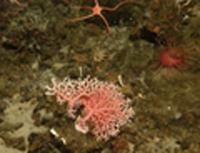
Delicate pink hydrocorals and various echinoderms were observed by the ROV. Remotely Operated Vehicles (ROV) remain an efficient technology to uncover the secrets of Antarctic seafloor fauna. As a precursor to the International Polar Year 2007/2008, the current Polarstern expedition conducted by the Alfred Wegener Institute for Polar and Marine research releases short seafloor video clips taken by ROV only a few hours after the robot has been recovered.
ROVs have become the standard non-invasive imaging tool for biologists from the Alfred Wegener Institute. For the current expedition, devoted to the study of continental shelf seafloor communities, which were once under the recently collapsed Larsen B ice-shelf, the ROV model Cherokee was selected.
"Inspection ROVs like the Cherokee are fast to deploy and easy to recover" explains the chief scientist and marine ecologist Julian Gutt, who can draw upon 15 years of experience investigating Antarctica's seafloor fauna using ROVs. Already used on a previous expedition, the ROV carries one still and three video cameras, including one high-resolution, as well as a manipulator enabling the collection of specimens. __IMAGE_2
Werner Dimmler, one of Europe's most experienced ROV pilots states: "It can dive down to 1000 meter depth, which is enough for the Larsen B ice-shelf area."
The first ROV footage, in relatively deep water, revealed an unusual environment characterized by pebble fields and rocks that have been scoured by ice over thousands of years. Delicate pink hydrocorals and various echinoderms were particularly conspicuous. Recently ice-scoured areas of the seafloor were completely devoid of life.
This expedition follows an integrated approach to obtain data from as many components of the Antarctic ecosystem as possible. Physical parameters of the water column as well as the seafloor are measured. The range of investigated organisms spans creatures as small as microorganisms, medium-sized invertebrates and fish, to the biggest of all animals, the whales.
"During the subsequent weeks researchers will try to answer the following question: What kind of biodiversity change do we expect after the collapse of the Larsen A/B ice-shelf, will an originally impoverished fauna flourish, or will species go extinct? " said Julian Gutt. Source : Alfred Wegener Institute for Polar and Marine Research
 Print Article
Print Article Mail to a Friend
Mail to a Friend
